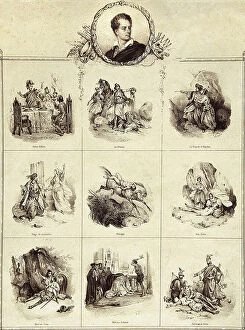6th Baron Collection
"Unveiling the Enigmatic 6th Baron: Exploring the Life and Legacy of George, Lord Byron" Step into the captivating world of George, Lord Byron (1788-1824
All Professionally Made to Order for Quick Shipping
"Unveiling the Enigmatic 6th Baron: Exploring the Life and Legacy of George, Lord Byron" Step into the captivating world of George, Lord Byron (1788-1824), as we delve into his intriguing life through a collection of remarkable images. Transport yourself to Newstead Abbey, Nottinghamshire, circa 1890, where this enigmatic figure once resided. The colour lithograph captures the grandeur and mystique surrounding his ancestral home. Thomas Moore, an Irish poet and biographer of Lord Byron, offers us a glimpse into their friendship with a portrait from around 1829. Their bond was one that endured both triumphs and tribulations. In "So let him stand. . " by George Cruikshank in 1820, we witness Byron's defiance against societal norms—a characteristic that defined him throughout his tumultuous existence. Richard James Lane's depiction from 1823 portrays a brooding yet magnetic presence—Lord Byron's piercing gaze hinting at the depths of his poetic genius. An unknown artist presents us with "Lines written in an Album" during Byron's time in Malta circa 1812. These words etched on paper reveal fragments of his soulful introspection. A vintage photograph from 1933 showcases George Lord Byron himself—an immortalized icon whose influence continues to resonate across generations. Dr. Glennies Academy stands as a testament to young Lord Byron's formative years in Dulwich Grove in 1820—a place where seeds were sown for future literary greatness. Palazzo Mocenigo becomes our portal to Venice in 1830—a city that captivated and inspired this wandering spirit who sought solace amidst its romantic canals and hidden corners. Journey back to the elegant splendor of Newstead Abbey during the eighteenth century—the very backdrop that nurtured Lord Byron’s creative brilliance while shaping his complex character.
















